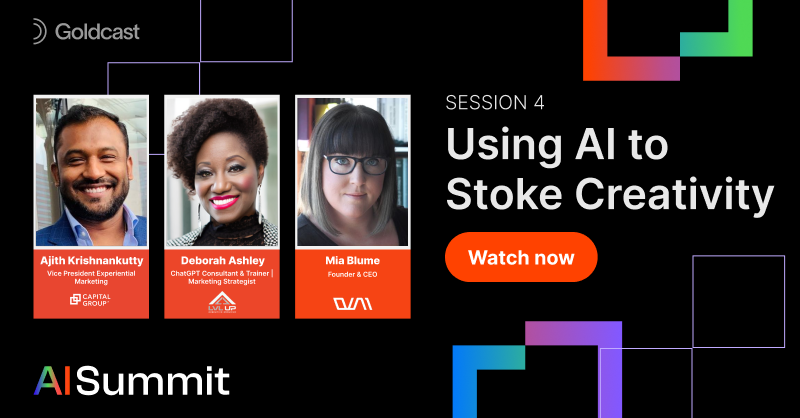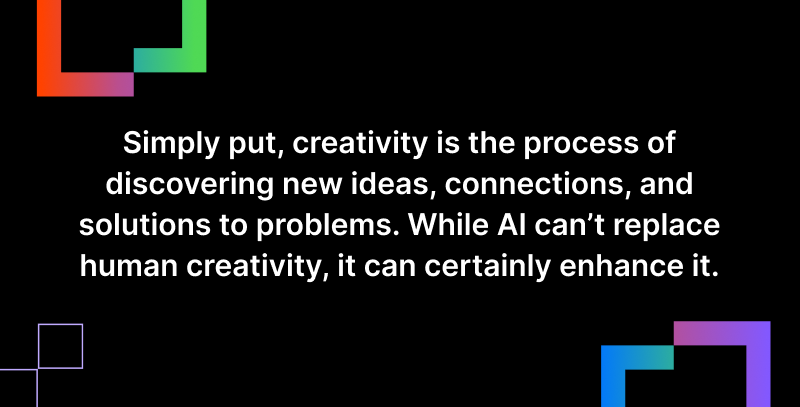AI and Creativity: Sparking New Ideas With AI Tools

Table of Contents
- The AI landscape in 2024 and beyond
- Why use AI to spark your creativity
- Using AI to stoke your creativity? Start with these best practices
- Top AI tools to boost your creativity
- 3 simple tips to avoid awkward AI moments
- How to encourage your team to use AI in the creative process
- 🚩Don’t forget the ethical implications
- Creativity reimagined: the AI advantage
Maximize Your Marketing ROI
Join 10,000 other marketers already getting the best tips on running engaging events that boost pipeline and create raving fans.
A blank page is a creative’s worst enemy. Whether you’re a writer, graphic designer, or videographer, you’ve likely felt the pressure of “banging out” another creative idea.
One of the biggest challenges is that it’s tough to create in a bubble. Sparking and building upon new perspectives is often easier with the help of a colleague or fellow creative. Unfortunately, we don’t always have that luxury.
Until now, that is. If you haven’t already, it’s time to introduce yourself to your new virtual brainstorming co-pilot: artificial intelligence (AI).
In this article, an exclusive group of marketing experts share their top tips and insights on using AI to spark creativity—including which tools they love, and how to avoid common generative AI (GenAI) pitfalls.
Still finding your feet with AI? View the full discussion on demand.

The AI landscape in 2024 and beyond
With the AI market currently expected to reach $1.3 trillion by 2032, AI is experiencing rapid adoption in marketing teams and the world at large. A whopping 92% of leading companies have invested in the technology and over half of them are already seeing increased efficiency.
“If you’re not embracing AI right now, you’re not on the right path,” says VP of experiential marketing at Capital Group Ajith Krishnankutty.
In the not-too-distant future, capabilities like natural language processing (NLP) will rapidly improve, helping AI models better understand intent and improve human-AI collaboration.
If you already use GenAI, you know its existing models can generate sophisticated media, text, and computer code. But AI’s generative abilities are predicted to continue improving exponentially as the technology evolves. You can’t afford to fall behind.
📚Read More: How to Use AI in B2B Event Marketing (+7 Tools for the Job)
Why use AI to spark your creativity
Before diving into our experts’ advice for using AI in your creative workflows, let’s take a minute to level-set. What exactly do we mean when we say “creativity”?

Simply put, creativity is the process of discovering new ideas, connections, and solutions to problems. While AI can’t replace human creativity, it can certainly enhance it.
“Once I got comfortable with the tools, I found myself feeling far more creative when using Midjourney and some of these other tools than I had in my entire career,” explains founder of Designing with AI and CEO of Design Department Mia Blume “I knew that was a pivotal moment. That was a signal to me that there was something new, something different here.”
The iterative process of interacting with AI can lead you down paths you didn’t expect and might not have found on your own.
This especially true when using GenAI to create things like:
- Written text
- Visual elements
- Video content
- Data analyses
ChatGPT expert Deborah Ashley believes AI tools can also serve as a powerful kickstarter to the creative process. The consultant, trainer, and marketing strategist at Level Up Executive Branding, uses it frequently for a variety of creative tasks.
“The thing that I like about AI tools in general is that they even the playing field,” Deborah explains. “In my consulting company, we wear several hats, and it allows us to get the job done a lot quicker.”
Using AI to stoke your creativity? Start with these best practices
AI can be a powerful ally to your creative process, but as the adage goes, “Garbage in, garbage out.” To get truly creative results, you have to have the right tools, approach, and prompts.
Here are four tips to master the learning curve of AI, with a little less “garbage” in the process.
Diversify your toolkit
There are thousands of AI tools already on the market. (If that feels overwhelming, hold tight—we list our experts’ favorites below.)
Try out a variety to see which ones work best for your industry and personal creative approach. Each tool has unique capabilities: images, text, music, code and more. Diversifying your toolkit exposes you to new sources of inspiration and allows you to refine your own creative process.
Iterate, iterate, iterate
The first thing AI spits out will almost certainly not be your dream version. Look at it as an iterative process—not a done-for-you solution.
Start with an initial prompt, review the output, then ask AI for adjustments. Remember, you’re in the driver’s seat. It’s up to you to remix and layer your prompts and AI responses to arrive at the best output.
“It’s really about helping you think,” explains Mia. Extensive iteration will help you finesse your final product until it’s something you can be proud of.
Be aware of potential bias
All three of our experts highlighted the existence of biases in AI systems. These models use large amounts of human input to generate output. If that information is biased (spoiler alert: it is), the output can be, too.
For example, asking an AI model to generate images of beautiful women will result in output that skews toward an idea of “beauty” that may or may not jive with your expectations or audience, depending on factors like culture, race, geography, and personal experience.
The first step toward mitigating these biases is awareness. The second step is process. (More on that in a minute.)
Invest in the right tools
While free AI tools are widely accessible, exploring paid programs is often worth it. Some of the main benefits of these upgraded tools are:
- Faster generation
- Higher output quality
- Better content privacy
You might end up with both free and paid AI tools in your tech stack. Either way, take time to understand exactly what the paid version offers so you can evaluate fully and make the right investment.
Top AI tools to boost your creativity
Once you’re ready to actively use AI in your day-to-day workflows, the next question is: Where the heck do you even start?
Depending on your goals and priorities, here are some of the top tools our experts recommend.
ChatGPT
You’ve already heard of this one. This natural language system chatbot can generate detailed text responses on a wide range of topics.
Deborah uses ChatGPT to generate content, develop and produce marketing events, and answer the key question: “What am I missing?”
“I build out this whole system, and I treat it like a team member, so it’s a conversation,” she explains.
To start the creative process of planning a webinar, Deborah takes the following steps:
- Describe the webinar’s audience and broad themes. Ask ChatGPT to generate an outline of the webinar content based on this information.
- Review the outline. Then ask ChatGPT: “What am I missing? What are the top three challenges that our audience is facing right now that we need to address?”
- Ask ChatGPT to incorporate that new information into the outline.
Of course, planning a stellar webinar involves much more than this. But this kind of conversation gives you a running start so you don’t have to plan from scratch—once again, avoiding that blank page.
ElevenLabs
Need quick audio, but hate being on screen? Deborah uses ElevenLabs to automatically create audio recordings of her own voice from a written script for things like pitches, presentations, and team training. It’s the perfect tool for creators who don’t love recording themselves.
Lumen5
Event marketers know that repurposing content is everything. Lumen5 is an AI-powered video maker that converts text scripts and media into video content by automatically generating visuals and voiceovers.
Descript
If you create a lot of video, Descript is a must. Its AI features include transcription, text-to-speech generation, and even automated editing. Seamlessly remove filler words and use your own voice to insert corrections into your audio.
Google TextFX
Writers, rejoice! Google has a free suite of AI tools, TextFX, to help you stylize text in different ways, like expanding length and changing tone. This tool is perfect if you already have your key messages nailed down, but need fresh new ways to express them in your content.
Midjourney
For imagery, Midjourney is at the top of the AI game. It generates detailed images from your text prompts, allowing you to bring visual concepts to life with a few keystrokes.
When it comes to using AI tools for creativity, experts like Mia believe it’s all about finding resources that make it easy to pivot from one idea to the next. “The tools that I come back to on a regular basis are the ones that allow me to jump to new ideas or generate pivots from where I’m already at,” she explains.
3 simple tips to avoid awkward AI moments
While the days of disturbing AI-generated hands and fingers are nearly behind us, our experts agree there are still plenty of ways GenAI can get things wrong.
Here are their tips to help you avoid common pitfalls when using AI in the creative process.
1. Get to know your tools
Take the time to understand the limitations of your AI tools. Which tokens work well with each model? What are the potential legal and data privacy risks of using this tool? How can you get the best results? What guidelines need to be in place to scale those results across multiple teams? With complete answers to these questions, you and your team can use new tools with confidence.
2. Train AI in your brand voice
To avoid sounding like everyone else using AI, start by training the tools you use on your unique brand voice. You can do this by sharing transcripts of existing video or audio content and telling the AI which words you definitely DO NOT use. Deborah also recommends a Chrome extension called AIPRM, which offers a wide range of prompts to help you achieve your desired output.
3. Don’t lose the human element
Ajith notes that while AI can help you enhance and scale creativity, a human touch remains indispensable—especially in event marketing. Make sure everyone on the team is aware of your human-first ethos when using AI. “In the events space, there’s still a lot of consumer experience, and I don’t think any of these tools are going to change that reality,” he comments. “People are going to make a difference. Talent will make a difference.”
How to encourage your team to use AI in the creative process
In almost every team, you’ll find folks who are in different places when it comes to AI. Whether your team is made of active adopters, skeptics or both, you’ll likely face some resistance when implementing this technology.
The key is to make sure each and every member of the team understands that AI is here to enhance their role, not replace it. AI won’t take your job anytime soon, but its widespread adoption is going to change your roles and goals.
Here are some simple tips to help you win the team’s support:
- Make it clear that AI is a tool, not a replacement
- Set clear guidelines for who retains final creative control (hint: this should always be a human!)
- Offer examples of real use cases and proven prompts to make it easy for them to get started
“AI is going to give people a head start, and help them work more efficiently while still exercising creative control and expertise,” Ajith explains. The experts agree. But retaining creative control is essential.
“Creativity is what defines us, not our tools,” says Mia.
“At the core, the humanity, the creativity, the message, the story—that’s fundamentally the ‘making.’” The way she sees it, creatives have always pulled inspiration from a variety of sources. Encourage any hesitant colleagues to approach AI as just another one of those sources.
🚩Don’t forget the ethical implications
The ethics of AI are a growing concern, especially in highly-regulated spaces like health and financial services. To move forward confidently, take time to understand the tradeoffs between maximizing creativity and mitigating risk when using AI.
For example, Mia teaches not to use tokens or prompts with proper nouns like artist and brand names. This will help prevent you from going straight to that source for your own content.
It’s also important to account for the fact that biases around race, gender, and other demographics are baked into AI models. Build processes in your prompts, plus regular reviews to check for biases in the content.
You can also create libraries to help team members generate content that reflects your diversity-related values. Pinpoint the right words, then encourage your team to use them.
The key is recognizing that AI won’t control for bias on its own. It takes intentional effort to select prompts and filter results to align with your ethical standards. With thoughtful and well-structured workflows, you can harness the creative benefits of AI without sacrificing your values.
Creativity reimagined: the AI advantage
A blank page can stop the creative process in its tracks, but AI offers a way forward.
By collaborating with virtual helpers like ChatGPT, Google TextFX, and Midjourney, you can generate ideas that might never have come on your own. Combining human ingenuity with AI’s rapid generative power opens up a world of possibilities—turning your blank page into a well of potential.
This expert discussion was too action-packed to miss. Dive in deeper as you experiment with your own creative tools and processes.

Stay In Touch
Platform
Resources
Company
Community
© 2025 Copyright Goldcast, Inc. All rights reserved.



 Upcoming Events
Upcoming Events Event Series
Event Series On-Demand Events
On-Demand Events

